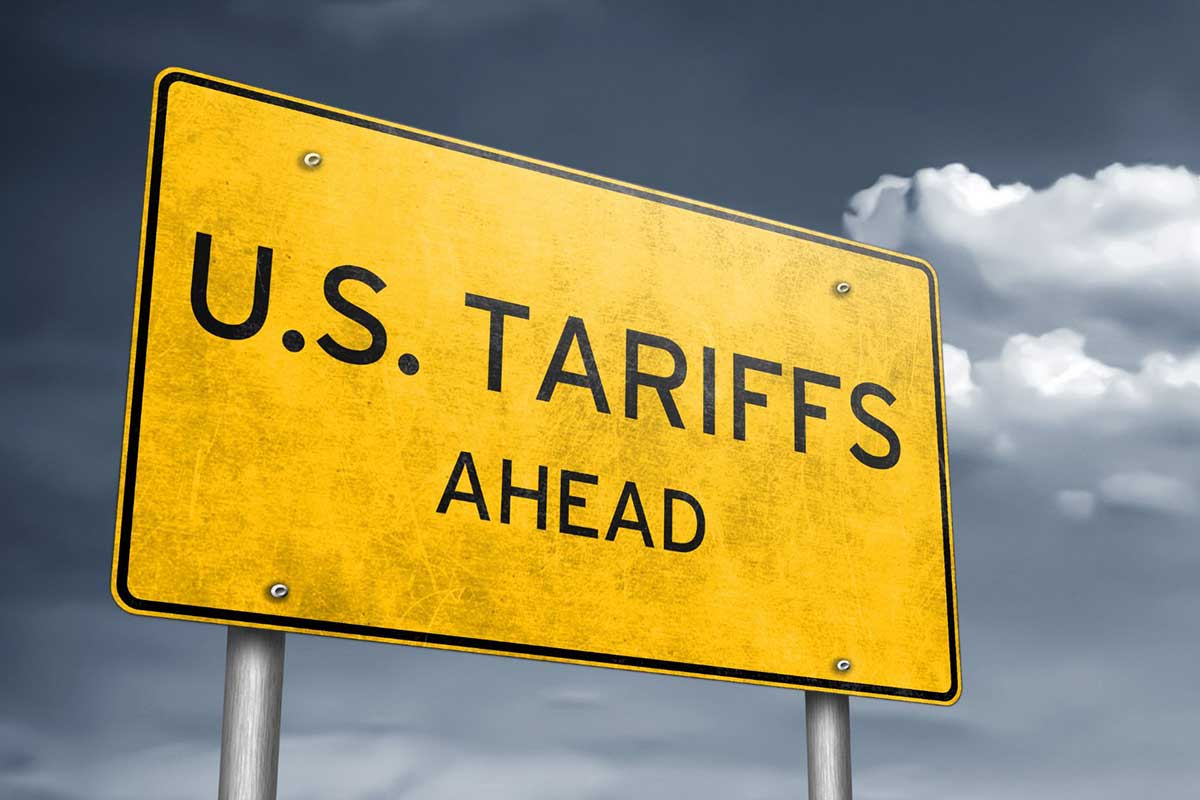Last Updated on June 27, 2025


Tariffs play a significant role in international trade, acting as a tool for governments to regulate the flow of goods and protect domestic industries. The recent trade war between Canada and the USA, sparked by tariffs imposed by President Donald Trump, has had profound effects on both economies. This article will explore what tariffs are, the reasons behind Trump’s tariffs, their impact on trade, and the consequences for us here in Canada.
What is a Tariff?
To understand the dynamics of the trade war between Canada and the USA, it is essential to first grasp the concept of a tariff. A tariff is a tax or duty imposed by a government on goods and services imported from another country. Tariffs are typically charged as a percentage of the price a buyer pays a foreign seller. The primary purpose of tariffs is to protect domestic industries by making imported goods more expensive, thereby encouraging consumers to buy locally produced items. Additionally, tariffs can generate revenue for the government and be used as a tool for negotiating trade agreements.
Historically, tariffs have played a significant role in shaping global trade. In the early 19th century, tariffs were a common feature of international trade policy, with many countries relying on them to protect their nascent industries. Over time, however, the trend shifted towards trade liberalization, with countries reducing tariffs to promote free trade and economic growth. The establishment of international organizations such as the World Trade Organization (WTO) further facilitated this shift by promoting the reduction of trade barriers and the resolution of trade disputes.
Historical Context of Tariffs in USA-Canada Relations
The economic relationship between Canada and the USA has long been characterized by close cooperation and mutual dependency. Both countries share one of the largest bilateral trading relationships in the world, with trade in goods and services amounting to hundreds of billions of dollars annually. The foundation of this relationship was laid in the 20th century with the signing of several trade agreements aimed at reducing tariffs and promoting free trade.
One of the most significant milestones in US-Canada trade relations was the signing of the North American Free Trade Agreement (NAFTA) in 1994. NAFTA, which also included Mexico, aimed to eliminate most tariffs and trade barriers between the three countries, fostering economic integration and boosting trade. The agreement led to a significant increase in trade and investment flows between Canada and the USA, benefiting industries and consumers in both countries.
Despite the overall positive impact of NAFTA, trade disputes occasionally arose between Canada and the USA, often centered around specific industries such as softwood lumber, dairy, and steel. These disputes were typically resolved through negotiations or the dispute resolution mechanisms established under NAFTA. However, the imposition of tariffs by the Trump administration marked a significant departure from the cooperative approach that had characterized US-Canada trade relations for decades.
Trump’s Tariffs and Their Effects
In his second term, President Donald Trump imposed a series of tariffs on Canadian goods, marking the beginning of a trade war between the two neighboring countries. The most notable of these tariffs included a 25% tariff on Canadian goods and a 10% tariff on Canadian energy products. These tariffs were part of a broader strategy by the Trump administration to reduce trade deficits, boost domestic manufacturing, and address what it perceived as unfair trade practices by other countries.
The imposition of tariffs on Canadian goods had several immediate and long-term effects on both economies. One of the most direct consequences was the increase in prices for consumers in both countries. The tariffs made Canadian goods more expensive for American consumers and vice versa, affecting a wide range of products including food, household items, and industrial materials. This increase in prices was particularly burdensome for low-income households, which tend to spend a larger proportion of their income on basic necessities.
The trade war also had a significant impact on businesses in both countries. Canadian exporters faced higher costs when selling their products in the US market, leading to reduced competitiveness and lower sales. Similarly, American businesses that relied on Canadian imports for their production processes faced increased input costs, which were often passed on to consumers in the form of higher prices. The uncertainty created by the trade war also led to disruptions in supply chains, as businesses sought to source their inputs from alternative suppliers.
The stock markets in both countries experienced declines as a result of the trade war. Investors were concerned about the potential negative impact of the tariffs on economic growth, corporate profits, and employment. The increased uncertainty and volatility in the markets led to reduced investment and lower stock prices, further dampening economic growth.
Another significant consequence of the trade war was the decline in the value of the Canadian dollar. The Canadian dollar fell to its lowest level against the US dollar in more than two decades, reflecting the economic uncertainty and reduced confidence in the Canadian economy. A weaker Canadian dollar made Canadian exports cheaper and more competitive in international markets, but it also increased the cost of imports, contributing to higher inflation.
Reasons Behind Trump’s Tariffs
Understanding the rationale behind Trump’s tariffs is crucial to comprehending the broader context of the trade war. The Trump administration cited several reasons for imposing tariffs on Canadian goods, including reducing illegal migration, addressing the smuggling of drugs like fentanyl into the US, boosting domestic manufacturing, and reducing the federal deficit.
One of the key arguments made by the Trump administration was that tariffs were necessary to protect American jobs and industries. Trump argued that the US had been taken advantage of by its trading partners, leading to job losses and declining industries. By imposing tariffs, the administration aimed to level the playing field and encourage businesses to produce goods domestically, thereby creating jobs and boosting economic growth.
Another reason cited by the Trump administration was the need to reduce the federal deficit. The US had been running large trade deficits with many of its trading partners, including Canada. The administration argued that tariffs would help reduce these deficits by making imported goods more expensive and encouraging consumers to buy domestic products. The revenue generated from tariffs would also contribute to reducing the federal deficit.
The Trump administration also linked the imposition of tariffs to national security concerns. Trump argued that tariffs on steel and aluminum were necessary to protect the US steel and aluminum industries, which are critical to national defense. Similarly, tariffs on Canadian energy products were justified on the grounds of reducing dependency on foreign energy sources and ensuring energy security.
Consequences of the Trade War
The trade war between Canada and the USA had several far-reaching consequences, affecting both economies and the broader global trading system. One of the most significant consequences was the strain on the economic relationship between Canada and the USA. The imposition of tariffs and the subsequent retaliatory measures by Canada created tensions and mistrust between the two countries, undermining the strong and mutually beneficial relationship that had developed over decades.
Both countries experienced economic pain as a result of the trade war. Businesses and workers on both sides of the border were affected, with many facing higher costs, reduced sales, and job losses. The increased costs for businesses were often passed on to consumers in the form of higher prices, contributing to inflation and reducing consumers’ purchasing power. The trade war also led to reduced investment and slower economic growth, as businesses faced uncertainty and instability.
The broader global trading system was also affected by the trade war. The imposition of tariffs and the resulting trade disputes raised concerns about the erosion of the rules-based international trading system. The World Trade Organization (WTO), which is responsible for promoting and regulating international trade, faced challenges in resolving the disputes and addressing the unilateral actions taken by the Trump administration. The trade war highlighted the need for reforms to the global trading system to address the changing dynamics of international trade and ensure fair and equitable trade practices.
Impact on Specific Industries
The trade war between Canada and the USA had varying effects on different industries, with some sectors experiencing more significant impacts than others. One of the industries that was particularly affected was the steel and aluminum industry. The imposition of tariffs on steel and aluminum imports aimed to protect the US steel and aluminum industries, which had been struggling with declining production and job losses. However, the tariffs also led to increased costs for American manufacturers that relied on steel and aluminum inputs, such as the automotive and construction industries. These increased costs were often passed on to consumers, leading to higher prices for vehicles, appliances, and other products.
The agricultural industry was another sector that faced significant challenges due to the trade war. Canadian agricultural products, such as dairy, maple syrup, and seafood, faced tariffs when exported to the US market. This led to reduced sales and increased costs for Canadian farmers and producers. The retaliatory tariffs imposed by Canada on American agricultural products, such as soybeans, pork, and apples, also affected American farmers, who faced reduced access to the Canadian market and lower prices for their products. The trade war highlighted the interdependence of the agricultural sectors in both countries and the importance of stable and predictable trade policies.
The energy sector was also impacted by the trade war. The tariffs on Canadian energy products, such as crude oil and natural gas, led to increased costs for American energy consumers and businesses. The energy sector is a critical component of the economic relationship between Canada and the USA, with significant cross-border trade in energy products. The tariffs created uncertainty and disruptions in the energy market, affecting investment decisions and supply chains.
Responses and Adaptations
In response to the trade war and the challenges it posed, businesses, industries, and governments in both countries took various measures to adapt and mitigate the impacts. Canadian businesses sought to diversify their markets and reduce their reliance on the US market by exploring new export opportunities in other countries. This included expanding trade relationships with countries in Europe, Asia, and Latin America. The Canadian government also implemented support measures for affected industries and workers, such as financial assistance, retraining programs, and market access support.
The American government also took measures to mitigate the impact of the trade war. This included providing financial assistance to farmers and industries affected by the tariffs, such as the Agricultural Trade Promotion Program and the Market Facilitation Program. These programs aimed to support American farmers by providing financial aid and helping them explore new markets and market access support.
One of the significant outcomes of the trade war was the renegotiation of NAFTA, which resulted in the United States-Mexico-Canada Agreement (USMCA). The USMCA, which came into effect on July 1, 2020, aimed to address some of the concerns raised by the Trump administration and modernize the trade relationship between the three countries. The agreement included provisions on labor rights, environmental standards, digital trade, and intellectual property protections. While the USMCA addressed some of the issues that had led to the trade war, it also introduced new challenges and areas of contention.
Is there a chance Canada avoids all this?
While avoiding tariffs entirely might be challenging, Canada has several strategies to mitigate their impact:
- Trade Diversification: Canada can seek new trade partners and markets to reduce dependence on countries imposing tariffs.
- Negotiations: Engaging in diplomatic negotiations to resolve trade disputes and potentially remove or reduce tariffs.
- Countermeasures: Implementing retaliatory tariffs or other measures to pressure the imposing country to reconsider their tariffs.
- Domestic Support: Providing support to affected industries and businesses to help them adapt and remain competitive.
While we remain optimistic, it’s wise to prepare for potential challenges. Canada and the U.S. share a long, prosperous history and a mutually beneficial relationship. We hope this continues without disruption.
Lessons Learned and Future Implications
The trade war between Canada and the USA under Trump’s tariffs offers several important lessons and implications for the future of international trade and economic policy. One of the key lessons is the importance of maintaining strong and stable trade relationships. The trade war highlighted the inter-connectedness of the global economy and the potential for economic disruption when trade disputes arise. It underscored the need for countries to work together to resolve trade issues through dialogue and negotiation, rather than resorting to unilateral measures.
Another lesson is the impact of trade policies on consumers and businesses. The increased costs and market disruptions caused by tariffs had significant consequences for both consumers and businesses, particularly in industries that rely on international trade. Policymakers must consider the broader economic impacts of trade policies and seek to balance the interests of different stakeholders, including consumers, businesses, and workers.
The trade war also highlighted the importance of diversifying markets and reducing dependency on a single trading partner. Canadian businesses that were heavily reliant on the US market faced significant challenges during the trade war. Diversifying export markets and building trade relationships with other countries can help mitigate the risks associated with trade disputes and economic disruptions.
Looking to the future, the trade war has important implications for the global trading system and the role of international organizations such as the WTO. The trade war raised questions about the effectiveness of the rules-based international trading system and the need for reforms to address the changing dynamics of global trade. Strengthening the multilateral trading system and ensuring fair and equitable trade practices will be crucial for promoting global economic stability and growth.

Conclusion
The imposition of tariffs by former President Trump and the resulting trade war between Canada and the USA have underscored the complex interplay between economic policy and international relations. While tariffs can serve as a tool for protecting domestic industries and addressing trade imbalances, they can also lead to higher prices, economic disruptions, and strained relationships with trade partners. The trade war between Canada and the USA had significant consequences for both economies, affecting consumers, businesses, and workers. It also highlighted the importance of maintaining strong and stable trade relationships, considering the broader economic impacts of trade policies, and diversifying export markets. As we move forward, it is essential to seek balanced and cooperative solutions that benefit all parties involved and promote global economic stability and growth.
Statistics and Information Sources:
- TD website
- Link: https://stories.td.com/ca/en/article/what-are-tariffs-us-canada






